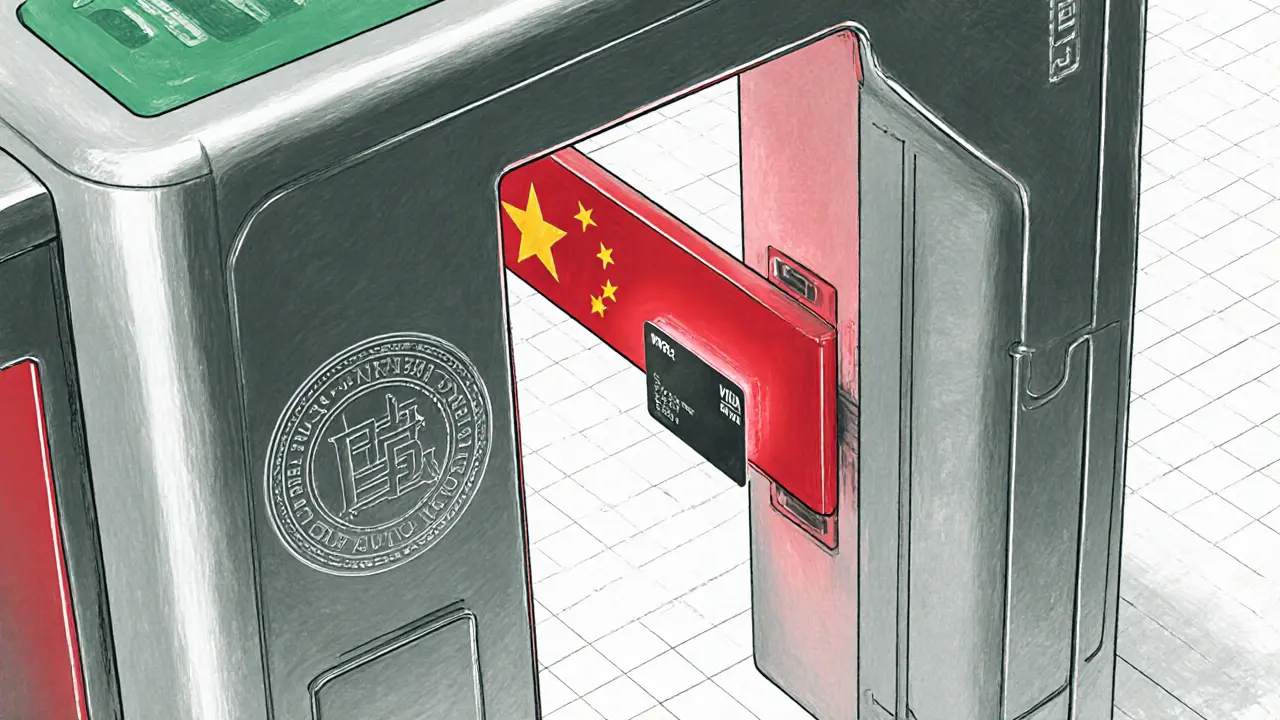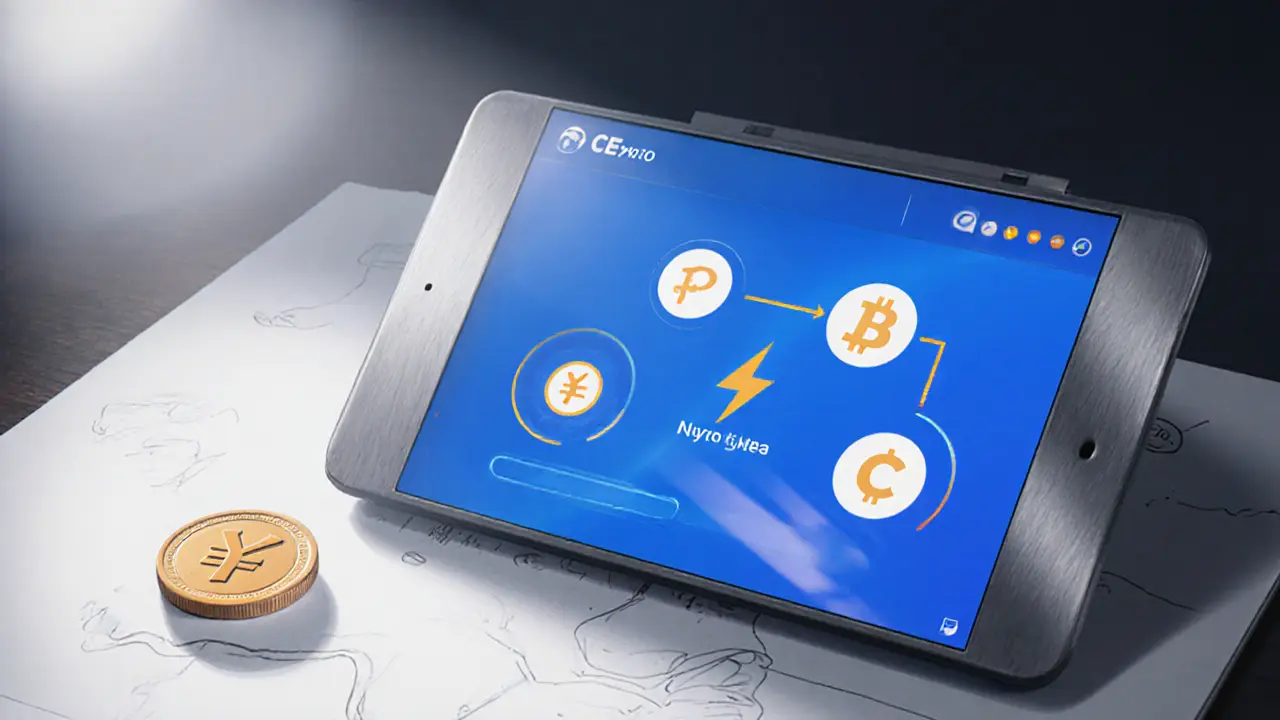Buy Crypto with Fiat in China: Step‑by‑Step Guide 2025

Crypto Buy Fee Calculator for China
Calculate Your Total Purchase Cost
Key Takeaways
- Domestic fiat‑to‑crypto on‑ramps are blocked - you must use international exchanges or P2P platforms.
- CEX.IO offers the simplest Convert workflow for beginners, while Binance and MEXC provide lower fees for larger trades.
- Always enable two‑factor authentication (2FA) and store the bulk of your holdings in a cold‑storage wallet.
- Peer‑to‑peer sites like LocalBitcoins and Paxful work, but you need strict counter‑party checks.
- Fees, KYC requirements, and payment‑method options differ widely - pick a platform that matches your risk tolerance and speed needs.
If you want to buy crypto China, you need to navigate a unique set of rules that blend strict regulation with clever work‑arounds. Below is a complete, up‑to‑date guide for 2025 that walks you from the legal backdrop to the exact clicks you’ll make on a popular exchange.
Understanding the Regulatory Landscape
Since the 2021 crackdown, the Chinese government has classified cryptocurrency as a non‑legal‑tender and banned domestic financial institutions from facilitating any crypto‑related transactions. This means banks, Alipay, and WeChat Pay will not process fiat deposits for crypto purchases. However, the ban does not criminalize ownership; it only limits the channels through which you can convert RMB into digital assets.
In practice, this forces Chinese residents to rely on two main avenues:
- International cryptocurrency exchanges that accept users from China and provide fiat on‑ramps via foreign bank accounts or card payments.
- Peer‑to‑peer (P2P) platforms that match you directly with a seller willing to accept RMB transfers, cash‑in‑person, or other informal methods.
Both routes have pros and cons, and the best choice depends on how quickly you need the crypto, how much you’re willing to pay in fees, and how comfortable you are with KYC (Know‑Your‑Customer) verification.
Choosing the Right Platform
When evaluating an exchange, look for these five criteria:
- Regulatory compliance: The platform should openly state that it serves Chinese users and has mechanisms to receive foreign fiat deposits.
- Payment‑method diversity: Credit/debit cards, Apple Pay, Google Pay, and bank transfers (often via USD, EUR, or GBP) give you flexibility.
- Fee structure: Taker and maker fees, withdrawal fees, and currency‑conversion costs add up. Lower percentages matter if you trade large amounts.
- KYC requirements: Some platforms (e.g., MEXC) allow limited trading without full KYC, but you’ll eventually need verification to withdraw.
- Security features: Look for 2FA, cold storage of the majority of assets, and a solid reputation among Chinese users.
Below is a quick snapshot of the most popular choices in 2025.
| Platform | Taker Fee | Maker Fee | Supported Fiat Methods | KYC Required? |
|---|---|---|---|---|
| Binance | 0.10% | 0.10% | Bank card, Apple Pay, Google Pay, SEPA transfer | Yes (basic verification for deposits) |
| MEXC | 0.01% | 0.00% | Bank card, direct deposit (SEPA), P2P | Optional for low‑volume trading |
| Kraken | 0.40% | 0.25% | Bank transfer (US, EU), credit card | Full KYC for withdrawals |
| Bitget | 0.10% | 0.10% | Bank card, Alipay (via P2P), USDT on‑ramp | Basic verification required |
| Swissquote | 0.25% | 0.25% | Bank transfer (CHF, EUR, USD) | Full KYC (broker‑regulated) |

Step‑by‑Step: Buying on CEX.IO
Among the international options, CEX.IO a globally regulated exchange that welcomes Chinese users and offers a dedicated Convert tool for fiat‑to‑crypto purchases stands out for its simplicity. Follow these steps:
- Create an account. Visit the CEX.IO homepage, click “Sign Up,” and provide a valid email address. Choose a strong password.
- Complete verification. Upload a government‑issued ID (passport or Chinese ID) and a selfie. Verification usually clears within a few hours.
- Select your fiat currency. CEX.IO supports USD, EUR, and GBP. Since direct RMB deposits aren’t accepted, you’ll need to convert RMB to one of these via a foreign‑exchange service or a trusted friend abroad.
- Deposit funds. Choose a payment method - Visa/Mastercard, Apple Pay, or bank transfer. Follow the on‑screen instructions; the deposit can take from a few minutes (card) to 2‑3 business days (bank).
- Use the Convert tool. Once the fiat shows in your CEX.IO Wallet, go to the “Convert” tab, pick the cryptocurrency you want (e.g., Bitcoin, Ethereum, USDT), enter the amount, and confirm. The conversion is instant.
- Secure your holdings. Transfer the purchased crypto to a personal wallet that you control. Enable 2FA on your CEX.IO account and consider a hardware wallet for large balances.
The entire process can be completed in under an hour if your verification clears quickly.
Peer‑to‑Peer Options: LocalBitcoins and Paxful
When you prefer to deal directly in RMB, LocalBitcoins a P2P marketplace that matches buyers and sellers for Bitcoin trades using local payment methods and Paxful another global P2P platform offering over 300 payment options, including Alipay and WeChat Pay are the go‑to choices.
Here’s a safe way to use them:
- Register and verify. Both sites require email verification; Paxful also asks for a phone number.
- Search for RMB offers. Filter by “CNY” and select a payment method you trust (e.g., bank transfer to a friend’s account).
- Check seller reputation. Look for at least 5‑star ratings, a high trade count, and recent positive feedback.
- Escrow protection. When you initiate a trade, the platform holds the Bitcoin in escrow until you confirm receipt of the fiat.
- Complete the trade. Transfer RMB to the seller’s account, then release the crypto from escrow.
Remember: P2P trades carry counterparty risk. Always start with small amounts, and never share your private keys.
Fee and Security Checklist
Before you fund any platform, run through this quick checklist:
| Item | What to Verify |
|---|---|
| Trading fees | Confirm taker/maker percentages and any hidden conversion fees. |
| Withdrawal fees | Check costs for moving crypto off‑exchange (e.g., Bitcoin network fee). |
| KYC scope | Know which verification level is needed for the trade size you plan. |
| Payment method fees | Card payments can add 2‑3% on top of exchange fees. |
| Security features | Enable 2FA, use anti‑phishing code, check if the exchange stores most funds in cold wallets. |
Platforms that score well across all rows are typically the safest bet for Chinese users.

Common Pitfalls & Troubleshooting
Deposit delays. International card deposits may be flagged by the bank. If you see a “pending” status for more than 24hours, contact the exchange’s support and have your bank confirm the transaction.
KYC rejections. Poor image quality or mismatched names (e.g., using a passport but the account name is in Chinese characters) cause failures. Use a clear, well‑lit photo and ensure the name matches exactly.
Exchange blocks. Some platforms occasionally block Chinese IP addresses temporarily. Use a reputable VPN service that offers servers in nearby regions (HongKong, Singapore) to regain access.
P2P scams. If a seller asks you to move funds after you’ve confirmed receipt, stop immediately. The escrow system is only valid while the trade is open.
Putting It All Together
To sum up, buying crypto with fiat in China today means you either:
- Choose an international exchange (CEX.IO, Binance, MEXC, etc.), convert RMB to a supported foreign fiat, deposit, and use the platform’s Convert or trade feature.
- Or go the P2P route (LocalBitcoins, Paxful) and trade directly with another Chinese user, relying on escrow protection.
Both paths require a solid security mindset: enable 2FA, keep large holdings off‑exchange, and stay updated on any regulatory announcements that could affect service availability.
Frequently Asked Questions
Can I use a Chinese bank card on Binance?
Direct Chinese bank cards are blocked on Binance. You need to first convert RMB to USD/EUR via a cross‑border service or use a foreign‑issued card.
Is peer‑to‑peer trading legal in China?
The law does not criminalize private ownership, but it forbids financial institutions from facilitating the trade. P2P platforms operate in a gray area, so you should proceed cautiously.
What’s the cheapest way to buy Bitcoin from RMB?
MEXC’s 0.01% taker fee plus low‑cost P2P matching often yields the lowest total cost, especially if you can find a seller with a favorable USD‑CNY rate.
Do I need to verify my identity to withdraw crypto?
Most reputable exchanges require full KYC before allowing fiat withdrawals. Crypto-to‑crypto withdrawals are usually unrestricted, but you’ll need a personal wallet.
How can I protect myself from scams on P2P sites?
Only trade with users who have a high rating, use the platform’s escrow, avoid off‑platform communication, and start with small trades to test the process.

Shrey Mishra
October 13, 2025 AT 08:29In the labyrinthine world of Chinese crypto on‑ramps, one must navigate not only technical hurdles but also an ever‑shifting regulatory tide. The guide’s step‑by‑step layout is commendably thorough, yet the emotional toll of constant vigilance cannot be overstated. Each conversion from RMB to a foreign fiat feels like an act of quiet rebellion, fraught with anticipation and dread. While the author extols the virtues of cold storage, the specter of surveillance looms over every transfer. Ultimately, the journey demands both patience and a resilient spirit.
Ken Lumberg
October 17, 2025 AT 07:09The moral calculus of sidestepping state bans is unsettling; one should not celebrate evasion as progress. When citizens resort to offshore platforms, the social contract erodes, fostering a climate of distrust. Regulations exist for a reason, and bypassing them only deepens the chasm between the governed and the govern‑makers. It is imperative to reflect on the broader implications of such financial subterfuge.
Blue Delight Consultant
October 21, 2025 AT 05:49One might ponder whether the pursuit of financial autonomy outweighs the peril of regulatory retribution. The guide offers pragmatism, yet the philosophical cost remains ambiguous.
Bruce Safford
October 25, 2025 AT 04:29There is a hidden agenda behind every “simple” instruction you see in these so‑called guides, and it is crucial to expose it. The Chinese authorities have long been infiltrated by a network of digital overlords who profit from the very chaos they publicly condemn. By using international exchanges, you are not only handing over your capital to foreign corporations but also feeding the data pipelines that monitor every transaction. Each time you convert RMB to USD on a platform like Binance, a silent agreement is forged between you, the exchange, and the state surveillance apparatus. The so‑called “Convert” tool is merely a façade for a deeper money‑laundering conduit that enriches elite financiers. Moreover, the P2P marketplaces such as LocalBitcoins are riddled with actors who masquerade as trustworthy sellers while colluding with organized crime rings. Their escrow mechanisms are deliberately designed to be opaque, allowing them to manipulate release conditions at will. The guide glosses over the risk that a single “bad actor” can compromise an entire network of users through phishing attacks. It also fails to mention the systematic throttling of VPN services that the government employs to cripple cross‑border traffic. As a result, users find themselves stranded, unable to access their own funds, while their digital footprints become a goldmine for intelligence agencies. The recommended security checklist, while well‑intentioned, is insufficient against a coordinated state‑level cyber offense. You are urged to consider hardware wallets not as an afterthought but as an essential bulwark against inevitable confiscation attempts. The narrative that “cold storage” is safe ignores the reality that physical devices can be seized under the guise of legal inquiries. Finally, the ever‑changing fee structures are not merely market driven; they are manipulated to create volatility that benefits the privileged few who control the order books. In light of these revelations, any casual foray into crypto within China should be re‑examined with the gravity of a covert operation.
Jordan Collins
October 29, 2025 AT 07:42Security is paramount.
Andrew Mc Adam
November 2, 2025 AT 00:49Indeed, safeguarding your assets goes beyond passwords; it demands a vigilant mindset, layered defenses, and an unwavering commitment to personal sovereignty. Embrace hardware wallets as your digital fortress, double‑check every link, and never underestimate the tenacity of adversaries lurking in the shadows. By treating security as a daily ritual, you transform vulnerability into resilience.
EDMOND FAILL
November 5, 2025 AT 17:56Yo, if you’re just getting started, pick a platform with a clean UI and low fees-Binance’s mobile app is pretty slick for quick buys.
Jennifer Bursey
November 9, 2025 AT 02:56From a fintech integration perspective, leveraging Binance’s API endpoints enables seamless fiat‑on‑ramp automation, while their tiered fee schedule orchestrates cost efficiency across volume brackets. The multi‑chain architecture also facilitates cross‑asset liquidity, which is pivotal for arbitrage strategies in a high‑volatility regime.
Kim Evans
November 12, 2025 AT 22:49Great rundown! Just remember to enable 2FA and keep your recovery codes safe 😊
shirley morales
November 16, 2025 AT 21:29While the guide is thorough it glosses over the systemic flaws that underpin crypto adoption in China
Della Amalya
November 20, 2025 AT 20:09Let us stride forward with courage, for every obstacle surmounted is a testament to our collective ingenuity; the cryptographic frontier awaits those who dare to explore its depths.
Teagan Beck
November 24, 2025 AT 18:49Totally agree, staying casual while staying safe is the sweet spot.
Wayne Sternberger
November 28, 2025 AT 17:29It is incumbent upon the discerning investor to conduct exhaustive due diligence, ensuring that each transactional vector aligns with both fiscal prudence and regulatory compliance, notwithstanding the occasional typographic irregularities that may arise.
Gautam Negi
December 2, 2025 AT 16:09Conversely, an over‑reliance on exhaustive due diligence can engender analysis paralysis, stifling the very innovation that propels the crypto ecosystem forward; sometimes bold, decisive action trumps meticulous scrutiny.
Shauna Maher
December 6, 2025 AT 14:49Honestly, the whole crypto hype is a massive distraction orchestrated by shadowy elites to siphon wealth from the masses, and any guide that doesn’t call that out is complicit.
Kyla MacLaren
December 10, 2025 AT 13:29While it’s easy to succumb to conspiratorial narratives, collaborating on transparent best‑practice frameworks can demystify the space and empower users rather than fuel cynicism.
Linda Campbell
December 14, 2025 AT 12:09It is the solemn duty of citizens to prioritize sovereign financial instruments over foreign digital constructs, thereby preserving the integrity of our nation’s economic autonomy.